Primarily, devout Hindus from all over the world participate in Kumbh Melas. The participation of Hindus is based on immense faith in the principles of Hinduism in order to obtain the benefits and improve their life. Kumbh Melas do not have any entry fee or registration. Anyone, even non-Hindus, can participate in Kumbh Mela and derive the spiritual benefits. However, the benefits obtained depend on the faith with which any of the activity is performed in the Kumbh Mela.
Who are the Kumbh mela participants ? In Kumbh Melas, Hindu organisations actively participate to educate and guide Hindus in following the principles of Hinduism. Kumbh Mela becomes a platform for all organisations to join hands together and support each other for Hindu Dharma.
The Kumbh Mela is an opportunity for different spiritual organisations and Saints to help Hindus understand Hinduism in a better way and to practice it.
Kumbh Mela is actively attended by devotees, Ascetics and Saints. Devotees come to the Kumbh Mela in large numbers.
Ascetics from different Akhadas also participate in the Kumbh Mela. Ascetics are experts in Holy scriptures as well as using traditional weapons. The reason these Ascetics learn to use weapons is because in the ancient times, they were the warriors for protecting Hindu Dharma from the invaders belonging to other religions. Hence, it was inevitable for the Ascetics and Saints in Akhadas to kill the invaders for protecting Dharma. Since a bath in the Ganga washes away sins, the weapon-wielding Ascetics and Saints in the Akhadas were given preference for the Rajyogi snan (Shahisnan). The tradition continues even today. The Rajyogi snan (Shahisnan) of the weapon-wielding Ascetics and Saints is considered the biggest ritual in the Kumbh Mela. Until the Ascetics have their Rajyogi snan (Shahisnan), the devotees do not bathe as a mark of respect.
Kumbh Mela participants – What happens at Kumbh Mela?
The Kumbh Mela is full of devotees, Ascetics and Saints who are involved in the activities given below:
1. Bathing in river : Many devotees have a Holy bath in the sacred rivers at the Holy place during the Kumbh Mela with the intention of nullifying their sins. Since bathing in River Ganga bestows special religious benefits, devotees and Saints bathe during the Kumbh Mela. By bathing during the Kumbh Mela, merits equivalent to performing 1,000 Ashvamedha Yadnyas, 100 Vajapeya Yadnyas and 100,000 pradakshinas (Circumambulations) around the earth are obtained. Similarly, by bathing once during the Kumbh Mela, merits equivalent to 1,000 baths in the Kartik month, 100 baths in the Magha month and 10 million baths in the River Narmada during the Vaishakha month are obtained. Holy Scriptures also mention that one attains Moksha (Final Liberation) by bathing in the holy river. Therefore, bathing in the holy river has immense importance during the Kumbh Mela.
2. Discourses by Saints: The lucid discourses of Ascetics and Saints on various topics like Dharma, Spirituality, Ramayan, Bhagawat etc. enhance the devotion of devotees. Of about 10,000 pandals (Tents) at the Kumbh Mela venue, most pandals arrange discourses daily on religious topics.
3. Singing hymns and devotional songs (bhajans)
4. Sacrificial fires (Yadnyas)
5. Rituals
6. Worship of Deities
7. Offering donations
8. Meditation
9. Penance
10. Spiritual practice
11. Rites:
A. Pitrutarpana : The main objective of Ganga is to bestow liberation to the departed ancestors. Hence, Dharma recommends performance of pitrutarpana (Ritual for the departed ancestors) in addition to bathing in the Ganga during the Kumbh Mela. ‘Vayu-purana’ says that the Kumbh Mela is useful for performing shraddha karmas.
B. Tiltarpan (Offering water to deceased ancestors)
C. Shraddha
12. Tonsuring: Importance of Mundan Sanskar (Tonsuring) during the Simhastha Kumbh Mela
आत्मन: शुध्दिकामो वा पितृणां मुक्तिहेतवे ।
वपनं कारयिष्यामि तीरेहं तव गाैतमी ।।
Meaning : O, River Gautami (Godavari), I am tonsuring on your banks in order to purify myself and for the liberation of my ancestors.
13. Debates about Dharma
14. Darshan of many Saints:
In the Kumbh Mela, the darshan of Saints enhances the devotion of devotees through darshan, Those who congregate in the Kumbh Mela include the Shankaracharyas of different peethas (Seats of faith) in Bharat, the Ascetics of 13 Akhadas, Mahamandaleshwars, followers of the Shaiva & Vaishnav sects, many scholars, renunciants, Saints and evolved souls. Hence, the nature of the Kumbh Mela is magnificent like the convention of Saints. Due to the Kumbh Mela, devotees get a golden opportunity to be in the company of Saints.
‘In the Kumbh Mela we get the darshan of evolved Saints who have spiritual powers after meditating in the Himalayas, the renunciants who travel on foot from Kashmir to Kanyakumari & the Saints-Mahants of weapon-wielding Akhadas. If we try to talk to them, we realise that they have immense knowledge and experience.
Devotees queue for darshan of not only Saints
following the Path of devotion, but of Hathayogis too
Hathayogi Ascetics (Followers of Path of Deliberate Rigours) also come to the Kumbh Mela. One finds many types of Hathayogis; for example, those who continuously stand on one leg, those who perform continuous shirshasan (A kind of yogasan), those who observe moun (Silence), those who survive only on air etc. and the devotees of Path of devotion queue up for their darshan.
15. Annakshetras (Free meals)
One common feature in the pandals or Akhadas of every sect is the annakshetra (Serving food as a spiritual ritual). Due to these annakshetras spread across the venue of the Kumbh Mela, thousands of devotees get food and water appropriately.
At the Kumbh Mela venue, some rich Akhadas organise annakshetras. The common perception is that annakshetras are meant for the poor. However, the bhandaras or annakshetras in the Kumbh Mela have a spiritual significance. Here, the rich devotees rub shoulders with the poor and eat meals as Prasad (Holy sacrament) of God.
Reference: Sanatan Sanstha’s Holy Text, ‘Glory of the Kumbha Parva’

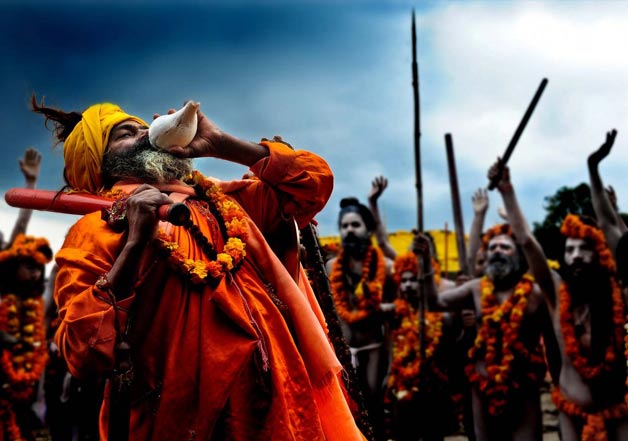
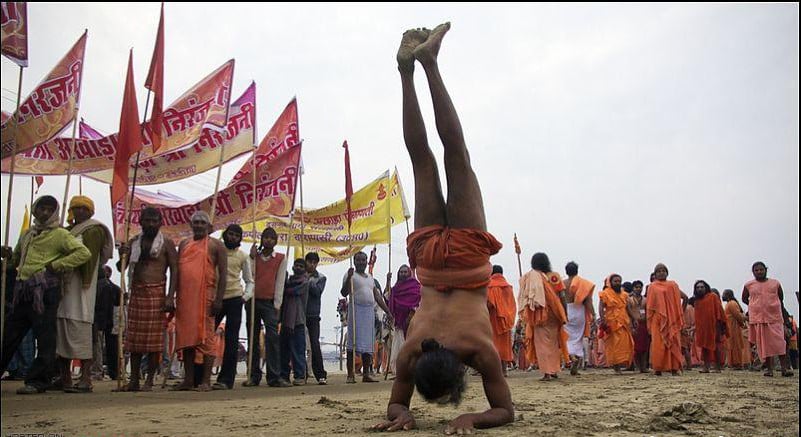
 Holy river
Holy river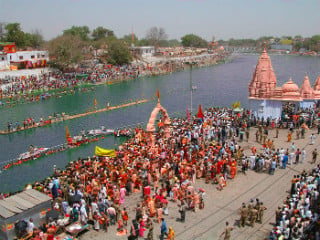 Bathing ghats located along Shipra River
Bathing ghats located along Shipra River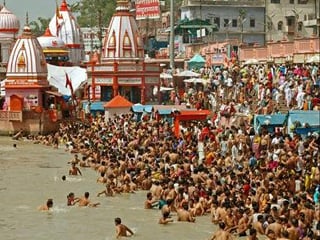 Main Bathing Dates for Kumbha Parva at Haridwar 2021
Main Bathing Dates for Kumbha Parva at Haridwar 2021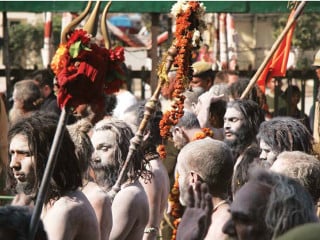 What is Akhada - List of Akhadas
What is Akhada - List of Akhadas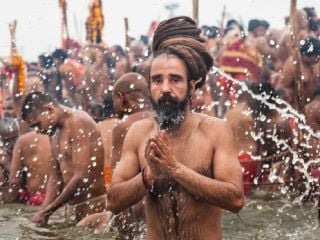 Shahi snan meaning and importance
Shahi snan meaning and importance